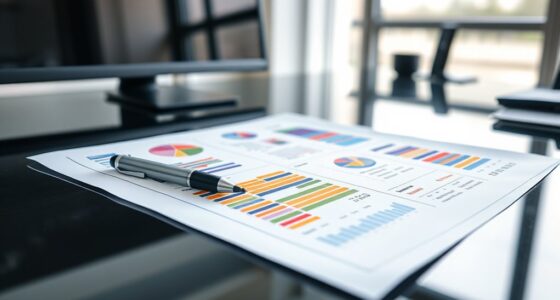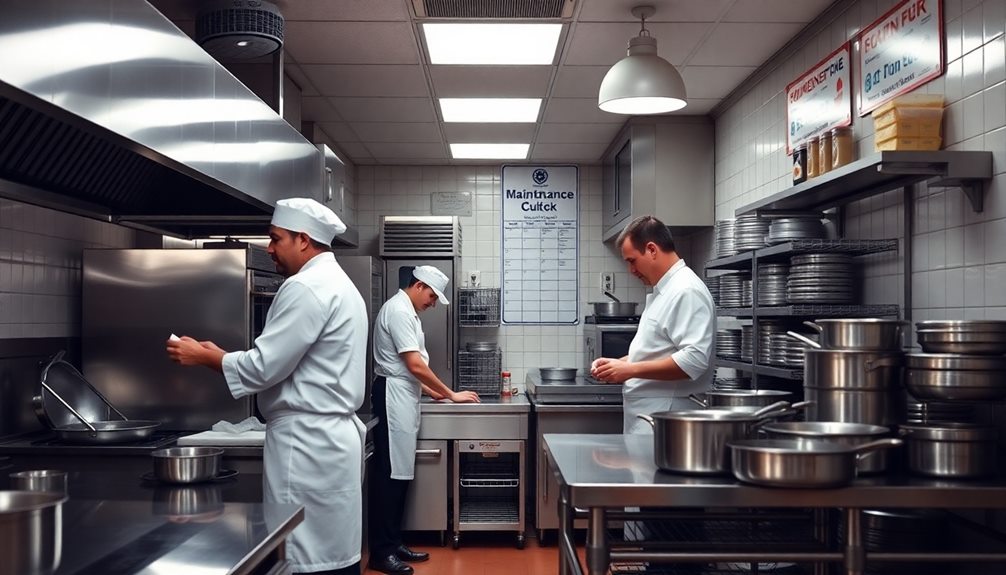To conduct a waste audit, start by defining clear goals and scope, assembling your team and gathering necessary tools. Then, collect waste samples from various locations over different times, while consistently recording data like date, location, and waste type. Next, sort waste into categories, measure quantities accurately, and analyze sources. Use this data to calculate key metrics like diversion rate and waste per unit. Continuing with these steps helps you identify opportunities for effective waste reduction strategies.
Key Takeaways
- Quantify waste sources by measuring total weight or volume over a specific period to establish a baseline.
- Calculate waste diversion rate: diverted waste divided by total waste, expressed as a percentage.
- Identify waste origins within processes by observing workflows, delays, and material use patterns.
- Set SMART reduction targets based on current data, with clear, measurable, and achievable goals.
- Continuously monitor key metrics like waste volume, diversion rate, and waste per unit to track progress and inform improvements.
Planning and Preparing for the Waste Audit
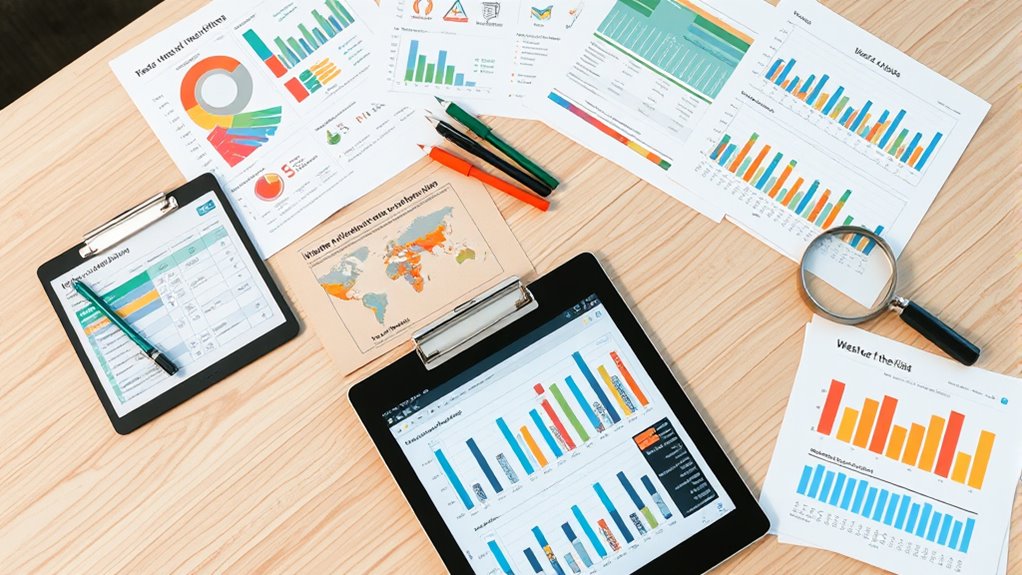
How do you guarantee your waste audit starts on the right foot? Begin by clearly defining your goals. Determine what you want to learn from the audit—whether it’s reducing waste, cutting costs, or improving recycling. Assemble a team with relevant expertise and assign specific roles. Gather all necessary tools, like waste collection containers, labels, and data sheets. Schedule the audit during a representative period, avoiding holidays or unusual activities that could skew results. Notify staff about the upcoming audit, emphasizing cooperation. Review existing waste management procedures to identify areas needing focus. By taking these steps, you set a solid foundation, ensuring your audit runs smoothly and yields accurate, actionable data. Proper planning is the key to a successful waste assessment.
Defining Scope and Objectives
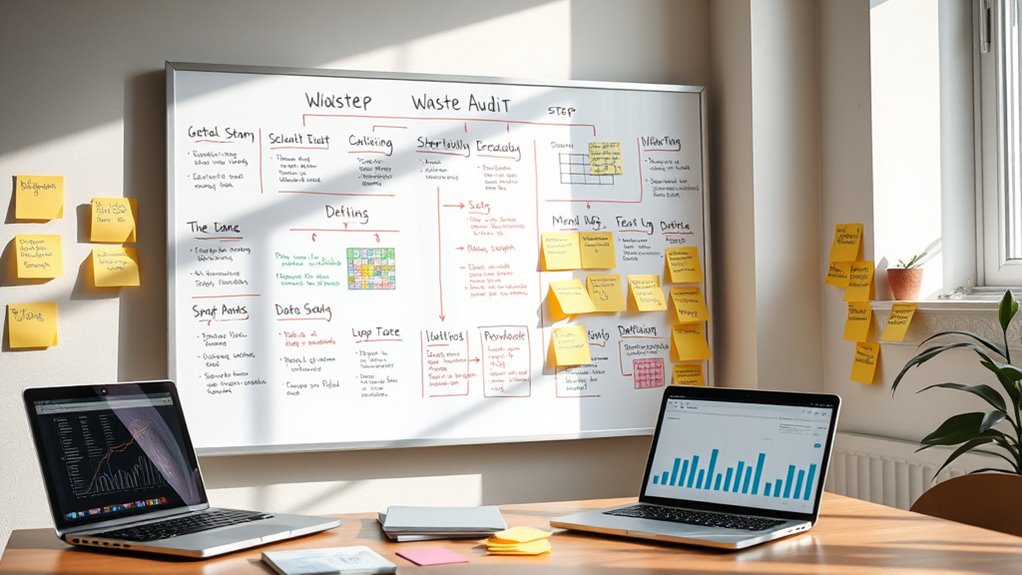
Before starting your waste audit, you need to clearly define its scope and objectives to guarantee focused and meaningful results. Determine which areas, departments, or processes you’ll include, considering factors like waste types and volume. Clarify your goals—are you aiming to reduce overall waste, identify contamination sources, or improve recycling rates? Setting specific, measurable objectives helps guide your efforts and keeps the audit focused. Also, consider the timeframe for data collection and the resources available. A well-defined scope prevents scope creep and ensures you gather relevant data. By establishing clear boundaries and goals upfront, you’ll streamline the process and make it easier to analyze results effectively. Incorporating automation technologies can assist in data collection and analysis, making the process more efficient. This step lays the foundation for a successful waste audit.
Collecting Waste Samples and Data

To gather accurate and representative waste data, you must systematically collect samples from the designated areas identified in your scope. Begin by choosing specific locations where waste accumulates, such as dumpsters, recycling bins, or workstations. Guarantee you collect samples at different times of day and on multiple days to account for variability. Use clear, labeled containers to avoid confusion, and record the date, time, location, and any relevant conditions during collection. Be consistent in your sampling method to ensure comparability. Handle waste carefully to prevent contamination or loss of materials. Regularly review your collection process to identify gaps or inconsistencies. Proper sampling lays the foundation for meaningful analysis and helps you understand waste generation patterns accurately. Additionally, understanding the Horsepower of Electric Dirt Bikes can inform insights into motor efficiency and energy needs during waste management processes.
Sorting and Categorizing Waste Materials

Effective sorting techniques help you separate waste quickly and accurately. When you categorize materials properly, it becomes easier to identify recycling opportunities and reduce contamination. Focusing on precision guarantees your waste audit results are reliable and actionable. Incorporating efficient sorting methods can further enhance the accuracy and effectiveness of your waste management process.
Efficient Sorting Techniques
Efficient sorting techniques are essential for maximizing waste diversion and simplifying recycling processes. By organizing waste at the source, you reduce contamination and improve recycling quality. Start by establishing designated bins for specific materials like plastics, metals, paper, and organics. Use clear labels and color coding to guide sorting efforts. Regular training ensures everyone understands proper procedures. Take a look at this visual to imagine the process:
| Waste Type | Sorting Method |
|---|---|
| Plastics | Separate by resin type |
| Metals | Rinse and sort by ferrous/non-ferrous |
| Paper | Flatten and keep dry |
This structured approach speeds up the process, minimizes errors, and enhances overall waste management efficiency. Stick to consistent techniques, and you’ll see better waste diversion results. Incorporating proper waste segregation practices can further optimize recycling outcomes.
Accurate Material Categorization
Accurate material categorization is essential for ensuring that waste is sorted correctly and can be recycled effectively. You need to identify each waste item precisely, distinguishing between plastics, metals, paper, and organics. Use clear labeling and proper tools to avoid confusion. Training staff on proper classification methods helps reduce errors and improves sorting speed. Pay close attention to material types that look similar, such as different plastics or contaminated paper. Consistent categorization ensures efficient recycling processes and reduces contamination, which can render batches unusable. Regularly review your sorting procedures and update categories as needed to reflect new waste streams or recycling standards. When you categorize waste accurately, you optimize recycling outcomes and contribute to a more sustainable waste management system. Additionally, cultivating attention during sorting can significantly enhance the accuracy and efficiency of the process.
Measuring and Recording Waste Quantities

How can you guarantee you’re capturing the true volume of waste your organization generates? Start by establishing clear measurement methods. Use standardized containers and scales to weigh waste consistently, avoiding estimations that can lead to inaccuracies. Record waste at specific points in the process to track fluctuations and identify trends. Implement a systematic logging system—whether digital or manual—that captures data each time waste is collected. Be sure to assign responsibility to trained personnel to ensure measurements are accurate and recorded promptly. Regularly calibrate scales and review procedures to maintain reliability. A consistent measurement approach is crucial for trustworthy data. Calibration processes help you understand waste volumes precisely, laying a solid foundation for effective waste management and reduction strategies.
Analyzing Waste Composition and Sources
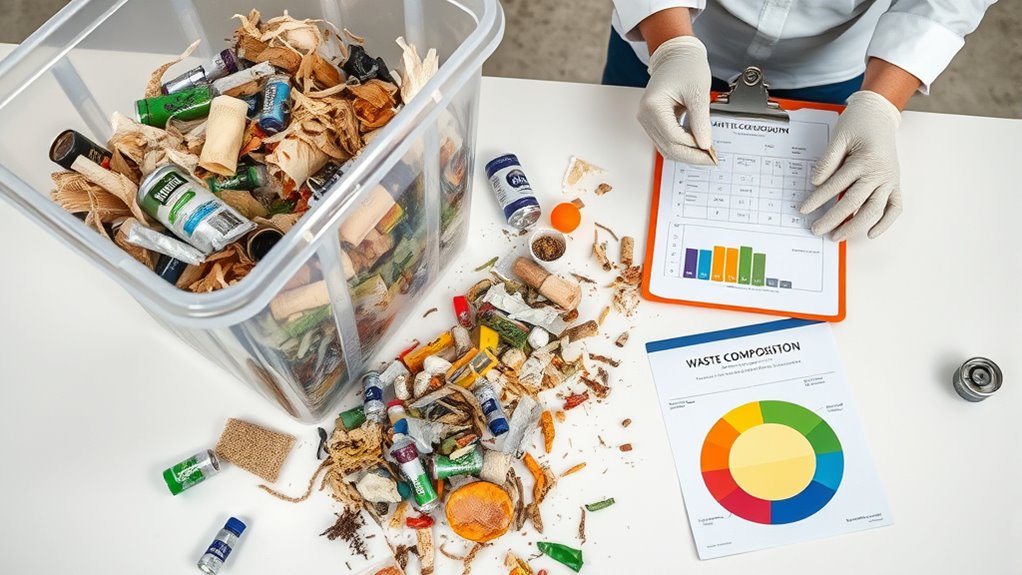
Understanding the composition and sources of your waste is essential for identifying key areas for reduction. By categorizing waste types—such as plastics, organics, paper, and metals—you pinpoint where most waste originates. This insight helps you target specific activities or processes that generate excess waste. For example, if a large portion of waste is packaging, you might explore reducing packaging or switching to sustainable alternatives. Tracing waste sources involves observing where waste accumulates, talking to staff, and reviewing waste disposal routines. This process reveals patterns and pinpoint hotspots that contribute most to overall waste. Analyzing waste composition and sources provides a clear picture of your current waste stream, enabling you to develop effective strategies for waste reduction and reuse. Incorporating portable waste management solutions can further enhance your waste audit by improving collection efficiency and data tracking.
Calculating Key Waste Metrics

Once you’ve identified the waste sources and composition, the next step is to quantify your waste stream through key metrics. These measurements help you understand the volume and impact of waste generated. First, track the total waste weight or volume over a specific period to establish a baseline. Second, calculate the waste diversion rate by dividing the amount of waste diverted from landfills by the total waste generated, expressed as a percentage. Third, measure the waste generation rate per unit of production or service, which reveals efficiency and areas for improvement. These metrics give you clear, actionable data to target reduction efforts. Regularly monitoring them guarantees you stay on track and identify trends or issues early. Incorporating relevant data from sources like waste audits or industry reports can further refine your understanding and strategies.
Developing Actionable Waste Reduction Strategies
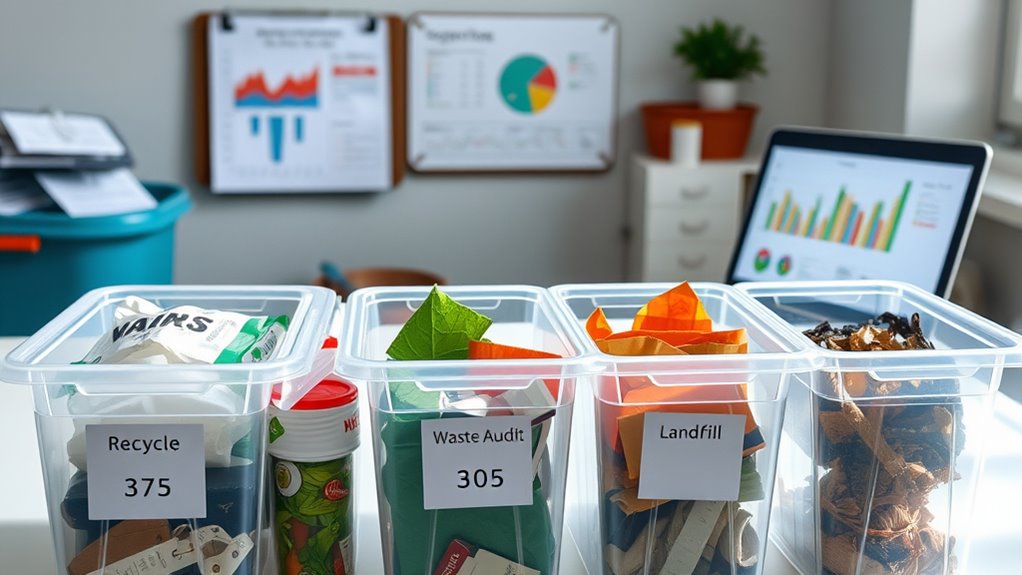
To develop effective waste reduction strategies, you need to identify where waste originates in your processes. Setting clear, achievable reduction targets helps you measure progress and stay focused. By pinpointing waste sources and establishing goals, you can create actionable steps toward minimizing waste. Incorporating vetted methods ensures your strategies are reliable and effective.
Identifying Waste Sources
How can you accurately identify the sources of waste within your operations? First, observe your processes closely—note where delays, excess, or defects occur. Second, analyze data from your waste audits to pinpoint patterns and recurring issues. Third, involve your team; frontline workers often spot waste sources overlooked by management. Use these steps to gather concrete evidence: 1. Map out your workflow to visualize waste hotspots. 2. Collect data on material usage, downtime, and reject rates. 3. Conduct interviews or surveys to get insights from employees working directly on the floor. Additionally, understanding hamster care costs can help you identify unnecessary expenses that may be considered wasteful in resource management.
Setting Reduction Targets
Have you established clear, measurable waste reduction targets to guide your improvement efforts? Setting specific goals helps you focus your actions and track progress effectively. Start by analyzing your current waste data and identifying realistic benchmarks. Use the SMART criteria—make your targets Specific, Measurable, Achievable, Relevant, and Time-bound. For example, aim to reduce waste by 20% within six months. Communicate these goals clearly to your team to foster accountability and collaboration. Break larger targets into smaller milestones to ensure steady progress. Regularly review your performance against these targets, adjusting strategies as needed. Establishing well-defined reduction targets keeps everyone aligned and motivated, ultimately driving continuous improvement in waste management.
Frequently Asked Questions
How Often Should Waste Audits Be Conducted for Optimal Results?
You might wonder how often to conduct waste audits for the best results. Generally, doing them quarterly works well, allowing you to track progress and catch issues early. If your organization produces a lot of waste or is trying to implement specific sustainability goals, monthly audits could be more effective. Ultimately, consistency is key, so set a schedule that fits your operations and review it regularly to optimize waste management.
What Tools or Software Assist in Waste Data Analysis?
Imagine you’re managing a facility and want to analyze waste data efficiently. Tools like WasteInsight help by providing real-time analytics, tracking waste patterns, and generating detailed reports. For example, a manufacturing plant used WasteInsight to identify high waste areas, reducing waste by 15%. You can also explore software like IBM Maximo or Enevo, which streamline data collection and analysis, making your waste management more accurate and actionable.
How to Engage Staff Effectively During Waste Audits?
You can engage staff effectively during waste audits by involving them early in the process, encouraging their input, and highlighting the benefits of waste reduction. Make it interactive with team challenges or incentives, and communicate clearly how their efforts make a difference. Providing training and sharing progress keeps motivation high. When staff see the impact of their contributions, they’re more likely to stay committed and proactive throughout the audit.
What Legal or Regulatory Considerations Impact Waste Auditing?
Think of legal and regulatory considerations as the backbone supporting your waste audit. You need to guarantee compliance with local, state, and federal laws, including waste disposal regulations, hazardous waste handling, and reporting requirements. Ignoring these rules can lead to hefty fines or legal trouble. Stay informed about regulations specific to your industry and location, and document your processes diligently to keep your waste audit sailing smoothly through compliance waters.
How to Prioritize Waste Reduction Strategies Post-Audit?
After your waste audit, you should prioritize waste reduction strategies by focusing on the areas with the highest waste generation or cost impact. Identify quick wins like reducing packaging or recycling more efficiently. Consider regulatory requirements to guarantee compliance. Engage your team for practical ideas, and set clear, measurable goals. Regularly review progress to adjust strategies, ensuring continuous improvement and maximum environmental and financial benefits.
Conclusion
By following these waste-audit steps, you’re planting seeds for a greener future. Think of your efforts as shaping a clearer lens through which waste transforms from clutter into opportunity. Each measurement and categorization acts as a brushstroke, revealing the bigger picture of sustainability. Embrace this process as your map to reduce waste, conserve resources, and turn your organization’s footprint into a thriving, eco-friendly landscape. Your actions today will bloom into a cleaner, healthier tomorrow.


